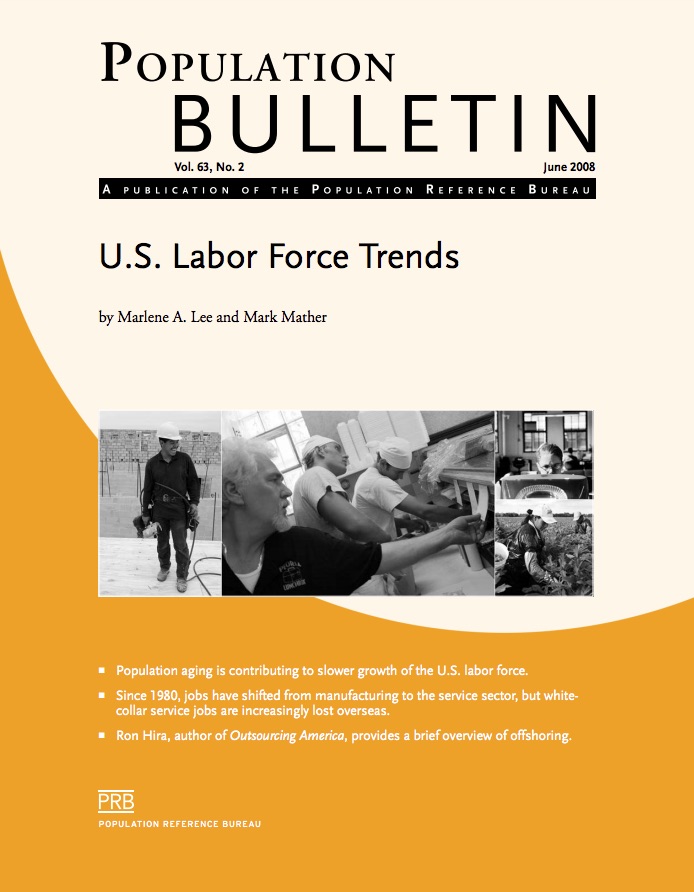
U.S. Labor Force Trends
Focus Area
During the past four decades, baby boomers coming of age and the rise in women’s labor force participation increased the size of the U.S. labor force which, in turn, helped fuel economic growth. The aging of baby boomers and the fact that women’s labor force participation has already peaked are expected to slow labor force growth in the near future. Many policymakers and business leaders are concerned that as baby boomers retire, labor productivity will drop as more experienced workers are replaced by people with fewer years on the job. But there are also potential benefits for those seeking employment. For example, with a smaller pool of potential workers, employers may provide extra incentives to retain employees or to encourage women, the elderly, or people with disabilities to enter the labor force. Another long-term employment trend since the 1970s has been a shift in employment and population growth away from the Midwest and Northeast toward the South and the West. Regional differences in wages and cost of living; the attraction of natural amenities; and a desire to escape congestion, pollution, and crime in urban areas spurred these changes in the 1980s and 1990s. Another related trend has been the growth of population and jobs in suburbs and a decline in central cities. Demographic trends, with younger populations in the West and South, suggest that these regional trends will continue.
This Population Bulletin examines demographic and socioeconomic characteristics of the U.S. civilian labor force and changes since 1950, and relates these trends to demographic and institutional changes and economic restructuring internationally and within the United States.
Some economists argue that technology changes, such as computerization, have tended to complement the work of higher-educated workers while replacing work for midlevel workers and hardly affecting the more manual work of the lowest-paid tier. They propose this as one reason for divergence in wages of the middle class and the highest earners. With the availability of inexpensive computers, demand has risen for the cognitive and interpersonal skills associated with educated professionals and managers. At the same time, demand for routine clerical and analytical skills used in many positions filled by middle-educated white-collar workers has declined. Technology has also reduced demand for routine manual skills used in high-paid manufacturing production jobs, but nonroutine manual skills used in many service jobs such as health aides, security guards, orderlies, cleaners, and food servers have not been affected by computerization. Recent trends in computerization of customer services and billing, as well as new technology that facilitates offshore outsourcing of these services, suggest that technology will continue to eliminate some U.S. jobs.
In a global economy, a country such as the United States is affected not only by its own demographic trends, but also by the trends and policies in other countries. Many U.S. and foreign-owned multinationals are shifting production from high-wage to low-wage countries, with China as one of the primary destinations for jobs. According to one study, companies shifting jobs tend to be large,well-established, publicly held corporations. Manufacturing firms are the main source of exported jobs, but offshore outsourcing of information technology jobs and customer service jobs continues to grow.
Unionized workplaces are disproportionately affected by U.S. production shifts offshore. A study by Bronfenbrenner and Luce in 2004 estimated that 53 percent of jobs shifting out of the United States to Mexico and 34 percent shifting to China were unionized. The loss of union jobs through offshoring means that jobs leaving the United States are more likely to be jobs with full health care and pension plans. In addition to being costly to workers, losing these types of jobs will be costly to some communities as this may result in a declining tax base and greater demands on social services.
Global corporate restructuring and other trends in the U.S. labor market also have the potential to exacerbate wage inequality. Corporate restructuring creates pressure to contain total compensation for many low-wage and mid-level workers but increases returns to managers at the highest levels where compensation may be linked to profits. In addition, the demand for higher-educated workers combined with technology will continue to widen the wage gap between the highly educated and the less skilled.
This Population Bulletin was funded through the generosity of the Alfred P. Sloan Foundation.

 ">
">